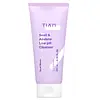What's inside
What's inside
 Key Ingredients
Key Ingredients

 Benefits
Benefits

 Concerns
Concerns

 Ingredients Side-by-side
Ingredients Side-by-side

Water
Skin ConditioningGlycerin
HumectantSodium Cocoyl Glycinate
CleansingSodium Lauroyl Glutamate
Silica
Abrasive1,2-Hexanediol
Skin ConditioningArtemisia Capillaris Extract
Carthamus Tinctorius Flower Extract
Skin ConditioningGardenia Florida Fruit Extract
Skin ConditioningMalt Extract
Skin ProtectingUlmus Davidiana Root Extract
Skin ConditioningCentella Asiatica Extract
CleansingPortulaca Oleracea Extract
Skin ConditioningHouttuynia Cordata Extract
Skin ConditioningAmaranthus Caudatus Seed Extract
Skin ConditioningLavandula Angustifolia Oil
MaskingCitrus Nobilis Peel Oil
MaskingJuniperus Virginiana Oil
MaskingRosmarinus Officinalis Leaf Oil
MaskingCitrus Aurantium Dulcis Peel Oil
MaskingMacadamia Ternifolia Seed Oil
EmollientLauryl Betaine
CleansingCitric Acid
BufferingSodium Chloride
MaskingAcrylates/C10-30 Alkyl Acrylate Crosspolymer
Emulsion StabilisingArtemisia Montana Leaf Powder
ExfoliatingButylene Glycol
HumectantPropanediol
SolventCandida Bombicola/Glucose/Methyl Rapeseedate Ferment
AntimicrobialCeramide NP
Skin ConditioningPolyglyceryl-10 Stearate
Skin ConditioningPanthenol
Skin ConditioningCetearyl Alcohol
EmollientSodium Stearoyl Glutamate
CleansingMadecassoside
AntioxidantHydroxyacetophenone
AntioxidantEthylhexylglycerin
Skin ConditioningLimonene
PerfumingLinalool
PerfumingWater, Glycerin, Sodium Cocoyl Glycinate, Sodium Lauroyl Glutamate, Silica, 1,2-Hexanediol, Artemisia Capillaris Extract, Carthamus Tinctorius Flower Extract, Gardenia Florida Fruit Extract, Malt Extract, Ulmus Davidiana Root Extract, Centella Asiatica Extract, Portulaca Oleracea Extract, Houttuynia Cordata Extract, Amaranthus Caudatus Seed Extract, Lavandula Angustifolia Oil, Citrus Nobilis Peel Oil, Juniperus Virginiana Oil, Rosmarinus Officinalis Leaf Oil, Citrus Aurantium Dulcis Peel Oil, Macadamia Ternifolia Seed Oil, Lauryl Betaine, Citric Acid, Sodium Chloride, Acrylates/C10-30 Alkyl Acrylate Crosspolymer, Artemisia Montana Leaf Powder, Butylene Glycol, Propanediol, Candida Bombicola/Glucose/Methyl Rapeseedate Ferment, Ceramide NP, Polyglyceryl-10 Stearate, Panthenol, Cetearyl Alcohol, Sodium Stearoyl Glutamate, Madecassoside, Hydroxyacetophenone, Ethylhexylglycerin, Limonene, Linalool
Water
Skin ConditioningCocamidopropyl Betaine
CleansingSodium Lauroyl Methyl Isethionate
CleansingSnail Secretion Filtrate
Skin ConditioningPolysorbate 60
EmulsifyingButylene Glycol
Humectant1,2-Hexanediol
Skin ConditioningAcrylates Copolymer
Tromethamine
BufferingEthyl Hexanediol
SolventSodium Polyacrylate
AbsorbentChamomilla Recutita Flower Oil
MaskingDipropylene Glycol
HumectantPanthenol
Skin ConditioningAllantoin
Skin ConditioningCitric Acid
BufferingPhenoxyethanol
PreservativeSodium Chloride
MaskingSodium Guaiazulene Sulfonate
Water, Cocamidopropyl Betaine, Sodium Lauroyl Methyl Isethionate, Snail Secretion Filtrate, Polysorbate 60, Butylene Glycol, 1,2-Hexanediol, Acrylates Copolymer, Tromethamine, Ethyl Hexanediol, Sodium Polyacrylate, Chamomilla Recutita Flower Oil, Dipropylene Glycol, Panthenol, Allantoin, Citric Acid, Phenoxyethanol, Sodium Chloride, Sodium Guaiazulene Sulfonate
 Reviews
Reviews

Ingredients Explained
These ingredients are found in both products.
Ingredients higher up in an ingredient list are typically present in a larger amount.
1,2-Hexanediol is a synthetic liquid and another multi-functional powerhouse.
It is a:
- Humectant, drawing moisture into the skin
- Emollient, helping to soften skin
- Solvent, dispersing and stabilizing formulas
- Preservative booster, enhancing the antimicrobial activity of other preservatives
Butylene Glycol (or BG) is used within cosmetic products for a few different reasons:
Overall, Butylene Glycol is a safe and well-rounded ingredient that works well with other ingredients.
Though this ingredient works well with most skin types, some people with sensitive skin may experience a reaction such as allergic rashes, closed comedones, or itchiness.
Learn more about Butylene GlycolCitric Acid is an alpha hydroxy acid (AHA) naturally found in citrus fruits like oranges, lemons, and limes.
Like other AHAs, citric acid can exfoliate skin by breaking down the bonds that hold dead skin cells together. This helps reveal smoother and brighter skin underneath.
However, this exfoliating effect only happens at high concentrations (20%) which can be hard to find in cosmetic products.
Due to this, citric acid is usually included in small amounts as a pH adjuster. This helps keep products slightly more acidic and compatible with skin's natural pH.
In skincare formulas, citric acid can:
While it can provide some skin benefits, research shows lactic acid and glycolic acid are generally more effective and less irritating exfoliants.
Most citric acid used in skincare today is made by fermenting sugars (usually from molasses). This synthetic version is identical to the natural citrus form but easier to stabilize and use in formulations.
Read more about some other popular AHA's here:
Learn more about Citric AcidPanthenol is a common ingredient that helps hydrate and soothe the skin. It is found naturally in our skin and hair.
There are two forms of panthenol: D and L.
D-panthenol is also known as dexpanthenol. Most cosmetics use dexpanthenol or a mixture of D and L-panthenol.
Panthenol is famous due to its ability to go deeper into the skin's layers. Using this ingredient has numerous pros (and no cons):
Like hyaluronic acid, panthenol is a humectant. Humectants are able to bind and hold large amounts of water to keep skin hydrated.
This ingredient works well for wound healing. It works by increasing tissue in the wound and helps close open wounds.
Once oxidized, panthenol converts to pantothenic acid. Panthothenic acid is found in all living cells.
This ingredient is also referred to as pro-vitamin B5.
Learn more about PanthenolChances are, you eat sodium chloride every day. Sodium Chloride is also known as table salt.
This ingredient has many purposes in skincare: thickener, emulsifier, and exfoliator.
You'll most likely find this ingredient in cleansers where it is used to create a gel-like texture. As an emulsifier, it also prevents ingredients from separating.
There is much debate on whether this ingredient is comedogenic. The short answer - comedogenic ratings don't tell the whole story. Learn more about comegodenic ratings here.
The concensus about this ingredient causing acne seems to be divided. Research is needed to understand if this ingredient does cause acne.
Scrubs may use salt as the primary exfoliating ingredient.
Learn more about Sodium ChlorideWater. It's the most common cosmetic ingredient of all. You'll usually see it at the top of ingredient lists, meaning that it makes up the largest part of the product.
So why is it so popular? Water most often acts as a solvent - this means that it helps dissolve other ingredients into the formulation.
You'll also recognize water as that liquid we all need to stay alive. If you see this, drink a glass of water. Stay hydrated!
Learn more about Water